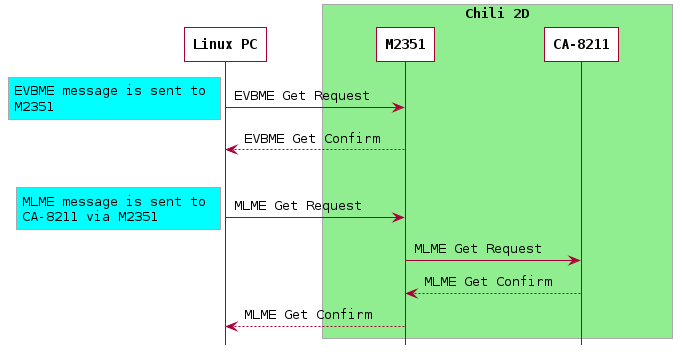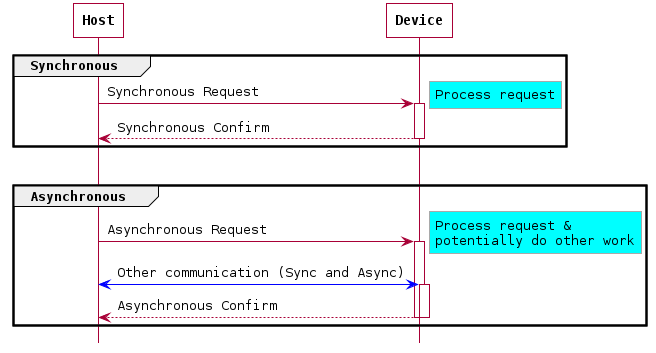cascoda-sdk-pages
Cascoda Message Format
The CA-821x platforms and Cascoda SDK all share the same, simple, binary message format which encapsulates data inside a packet comprising of a Command, Length then Payload. This format is commonly known as a TLV (Type, Length, Value). In the case of Cascoda messages, the Command and Length fields are each 1 octet. The Payload is a field with a length in octets as specified by the Length field. Many Cascoda message commands operate in a Request/Response manner, with both synchronous and asynchronous responses possible. The Request/Confirm/Indication/Response terminology is used from the IEEE 802.15.4 spec.
- Indication: A message from the device to the host
- Request: A message from the host to the device
- Confirm: A message from the device to the host, in response to a request
- Response: A message from the host to the device, in response to an indication
The term ‘Host’ refers to the higher level ‘controlling’ platform, and the term ‘Device’ refers to the device being controlled. For instance, when you plug a Chili2D dongle into a PC, the PC is the host of the M2351 microcontroller on the Chili2D, and the M2351 is the host of the CA-8211.
The use of the Cascoda message format is specified in more detail for the CA-821x platforms in the respective datasheets, available on the Cascoda website under the relevant product.
This information is only required for informational/analysis purposes, or if writing a custom driver. If using the Cascoda SDK, then the functions in ca821x-api/include/ca821x_api.h, posix/ca821x-posix/include/ca821x-posix/ca821x-posix-evbme.h should be used instead of constructing messages directly.
Message Structure
The structure of a Cascoda TLV message is quite simple, and comprises of 3 fields.
- The first field of the message is the
Commandfield. It is one octet in length. - The second field of the message is the
Lengthfield. It is one octet in length. - The third field of the message is the
Payloadfield. It isnoctets in length, wherenis the value of theLengthfield. The contents and structure of thePayloadfield depend on the value of theCommandfield.
| Field Name | Command | Length | Payload |
|---|---|---|---|
| Field Length (octets) | 1 | 1 | (Length) |
Command
The Command field, sometimes called the Command ID or CmdId field, describes how the Payload field should be interpreted. In addition, bit 6 (0x40) affects the message flow. If a Command has bit 6 set, then the command should be treated as a ‘Synchronous’ command. If not, it is an ‘Asynchronous’ command. See the Asynchronous/Synchronous section for more info.
The Command field also determines which layer shall process the command. For instance, some will be processed by the MAC on the CA-821x, whereas others will be processed by the Evaluation Board Management Entity (EVBME) on the host processor.
For example, in the situation where a Linux PC is communicating over USB to a Chili 2D dongle (which includes an M2351 host CPU and CA-8211 transceiver), the following exchange is possible:

The definitive list of commands that go to the EVBME can be found in ca821x-api/include/evbme_messages.h in enum evbme_command_ids. The definitive list of commands that go to the MAC (CA-821x) can be found in ca821x-api/include/mac_messages.h in enum spi_command_ids. The CA-821x datasheets also contains a detailed list of the commands and the payload structures.
Length
The Length field describes the length of the Payload field. It can have any value in the range 0-254 (inclusive).
Payload
The Payload field is binary data. The structure, characteristics and semantics of the content is determined by the Command field, and the length is determined by the Length field. For the structure of the Payload for CA-821x commands, consult the datasheet, available on the Cascoda website under the relevant product. The ca821x-api/include/mac_messages.h header can also be used. For the structure of the Payload for EVBME commands, consult the ca821x-api/include/evbme_messages.h header.
Asynchronous/Synchronous commands
For Request – Confirm primitive pairs there are 2 message types: synchronous and asynchronous messages. Although there is no distinction between the physical data exchange for a synchronous and asynchronous message packet, synchronous messages require an immediate confirm and are therefore treated with priority. Asynchronous messages do not require or cannot return an immediate confirm, such as a MCPS-DATA Request, where the confirm can only be issued once the data packet has been sent.
For this reason, when a synchronous request is sent, no further message should be sent until the corresponding confirm has been received. It is permissible to use a sensible timeout such as 500ms, but a failure here is extremely rare and potentially represents a fatal error that should not go unhandled.

Additional notes
0xFF Command ID/Length
The Command and Length field value ‘0xFF’ is reserved, and cannot be used. In the SPI protocol between the CA-821x, it is used as the ‘idle’ octet, signifying that there is no data to transmit. This is required due to the nature of SPI being always bidirectional.